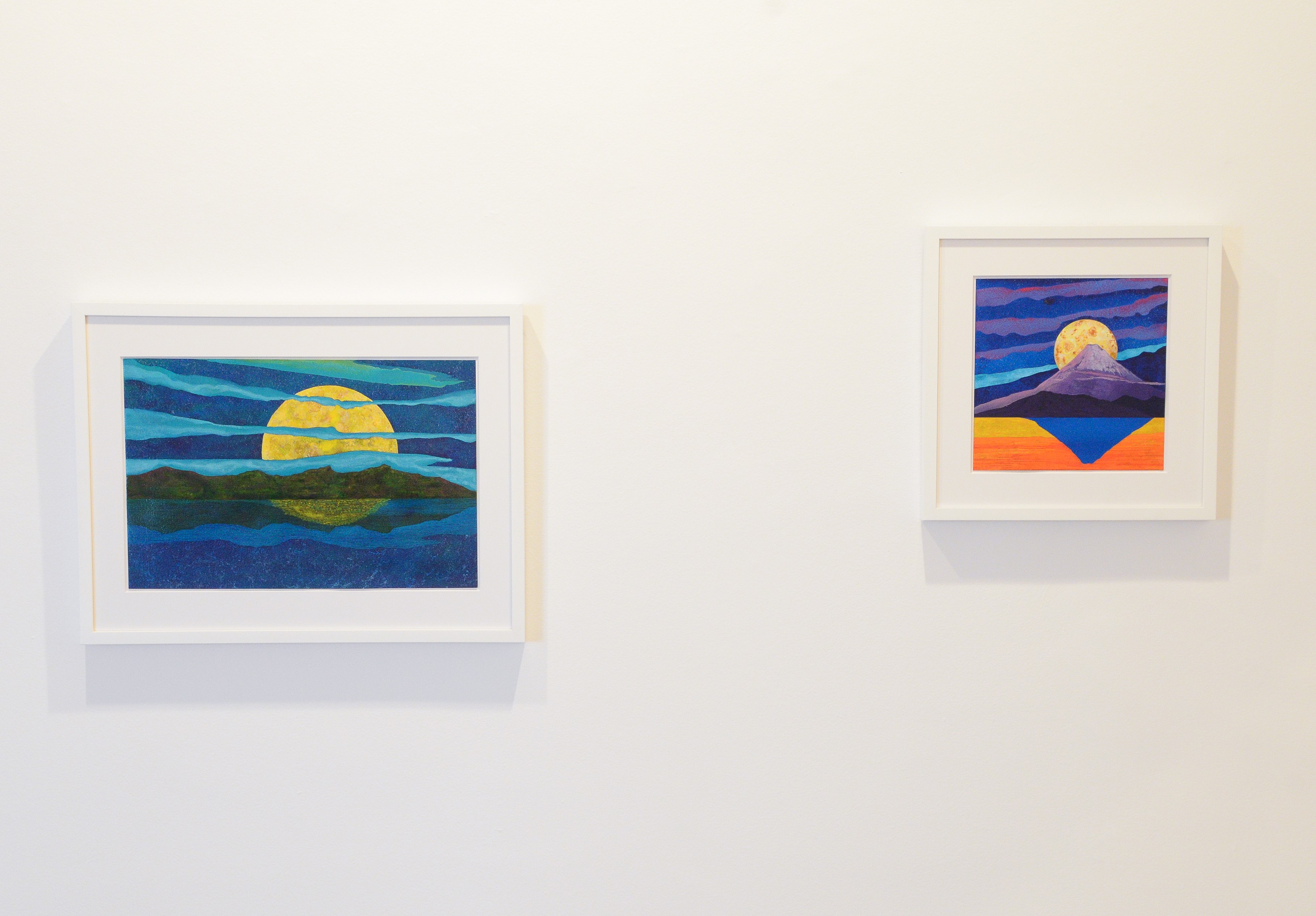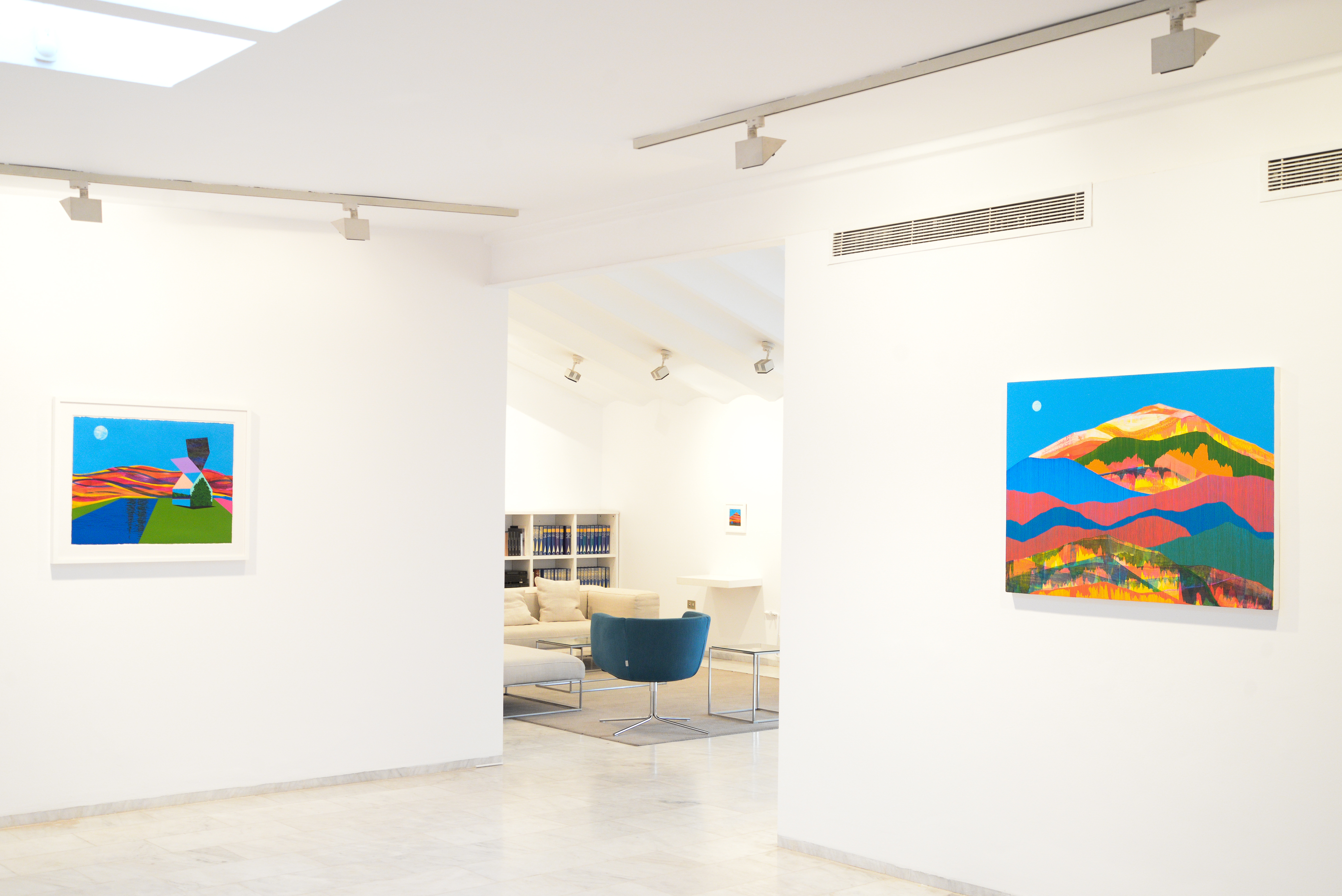"Future Memory", más allá de la exposición / "Future Memory", beyond the exhibition

*(English below)
Anne Ray es escritora, editora y pareja del artista que actualmente se expone en nuestra galería de arte contemporáneo en Valencia. Cuando contactamos con Isherwood y empezamos a dar forma a lo que hoy se puede disfrutar como “Future Memory” pensamos en Anne como una buena figura ajena que acercase la obra del artista a un mayor público.
Anne Ray cuenta con una larga trayectoria en el mundo de la narrativa. Sus relatos han sido publicados en más de diez revistas de su país natal, Estados Unidos, donde destacan títulos como StoryQuarterly o Gettysburg Review. Su obra gira principalmente en torno a la ficción, creando realidades y situaciones imposibles, tales como las que se muestran en la obra de Isherwood.
Esperamos que disfrutes de su perspectiva a la hora de leer la obra, y descubras con la siguiente entrevista, más entresijos de nuestra actual exposición.
1. ¿Qué dificultad encontraste a la hora de enfrentarte a la obra de James y tener que describirla?
En muchos sentidos, encontrar las palabras para describir la obra de James fue fácil. Quizás sea porque en mi propio trabajo como escritora de ficción, el paisaje y el mundo físico son importantes para mi pensamiento. También me parece que su obra contiene a menudo una narrativa oculta, y la narrativa es, por supuesto, tan importante para la ficción. Por eso, la experiencia de describir las obras fue una buena oportunidad para activar muchas de las conexiones a las que había querido poner palabras.
2. ¿Qué elementos destacarías dentro de su obra? ¿Qué es lo que más te llama la atención de la obra de James a nivel técnico?
Hay, por supuesto, muchas formas y características estructurales que aparecen y reaparecen y se repiten en los cuadros, y que se me quedan grabadas: las lunas, por supuesto, pero también la casa llena de atrevidas rayas de color, o los afilados cipreses que sobresalen en el cielo.
Otro es el campo de estrellas. Desde el punto de vista técnico, estas estrellas siempre me sorprenden por su precisión y por la habilidad con la que retratan el cielo nocturno. Pero a nivel técnico, incluso más que estos elementos, lo que me llama la atención son las capas ocultas.
Tengo la suerte de que durante muchos años James hizo su trabajo en una habitación de nuestro apartamento de menos de dos metros cuadrados. Es una suerte para mí, pero no tanto para James, ya que hace unos años perdió un espacio de estudio asequible debido al exceso de urbanización. (Esto le ha ocurrido a innumerables artistas, pero ese es un tema para otro día. Hoy en día, está de vuelta en un nuevo espacio de estudio).
Pero para mí, pude ver que los cuadros suelen comenzar con una capa efímera de un solo color, y sobre ella vienen miles de pasos para lograr la complejidad que vemos. Esa primera capa siempre me llamó la atención cuando los cuadros se secaban en nuestra casa. Una capa aplicada con una medida de casualidad, y maravillosamente instintiva.

3. ¿Consideras importante que la obra llegue a ojos del espectador desde otra perspectiva diferente a la del artista?
Es inevitable que las obras lleguen al espectador de una manera distinta. Cuando una obra está terminada, el plan de James para que llegue al espectador está trazado. Cualquier control que haya podido tener sobre ella se telegrafía al espectador, que entonces aporta su propia nostalgia, sus propios recuerdos. Aunque la precisión de los cuadros sugiere que se pretende un gran control, creo que la propia perspectiva del espectador es lo que hace que los cuadros estén acabados. Creo que esto se evoca en el título: invita al espectador a un recuerdo que pronto tendrá al acercarse al cuadro. De ahí lo de " Future Memory".
4. ¿Son los paisajes estadounidenses parte de la inspiración de James para crear su obra?
Absolutamente. Veo en los EEEUU rastros de paisajes propios, de ambientes y estilos arquitectónicos. Tanto los paisajes como la arquitectura son una influencia importante. Algunos elementos arquitectónicos de las obras hacen referencia a un edificio único, mientras que otros se refieren a un estilo que realmente sólo puede sentirse en casa en un lugar concreto. Las casas de tablas de madera de Cape Cod, en el mismo estado en el que James se crió, por ejemplo. Pero siempre son singulares en la obra de James.
5. ¿Por qué es importante la obra de James en tiempos actuales?
Su obra es importante en los tiempos actuales por su conexión con la nostalgia por el mundo natural, y por un lugar tranquilo en él. Por supuesto, sus paisajes no siempre reflejan una sensibilidad pacífica, a veces reflejan la agitación. Para mí, esta dicotomía se refiere a la tensión humana en torno a nuestro mundo cambiante y a la forma en que hemos alterado totalmente el medio ambiente. Necesitamos esta obra, al igual que necesitamos el mundo natural.
6. ¿Entrevés cierta relación entre los cuadros o deberían observarse como obras aisladas?
Como soy escritora de ficción, quiero ver historias en todas partes. Así que sería natural para mí ver un arco largo a través de todas las obras. Pero tengo una opinión firme al respecto, extraña quizás, y es que deben leerse individualmente. Lo que crea continuidad entre ellas es la técnica y la paleta, más que la historia o el tema. Es algo que me gusta de ellos. Incluso si tuvieras diez de ellos en tu casa, aportas tu propio contexto a cada uno tal cual.
Es como lo contrario de un cuadro de citas de On Kawara. (¡Aunque me encantan!) Sin embargo, podría ver cómo surge una conexión más global o cómo cambia a medida que James aumenta la escala. ¿Una serie de cinco? ¿Un tríptico? Sería muy emocionante verlo.

Anne Ray is a writer, editor and partner of the artist who is currently exhibited in our contemporary art gallery in Valencia. When we contacted Isherwood and began to shape what can be enjoyed today as "Future Memory" we thought of Anne as a good outsider who would bring the artist’s work to a greater audience.
Anne Ray has a long history in the world of narrative. His stories have been published in more than ten magazines in his native United States, where titles such as StoryQuarterly and Gettysburg Review stand out. His work revolves mainly around fiction, creating impossible realities and situations, such as those shown in Isherwood’s work.
We hope you enjoy his perspective when reading the work, and discover with the following interview, more details of our current exhibition.
1. What difficulty did you encounter in confronting James' work and having to describe it?
In many ways, finding the words to describe James' work was easy. Maybe it’s because in my own work as a fiction writer, landscape and the physical world are important to my thinking. It also seems to me that his work often contains a hidden narrative, and narrative is, of course, so important to fiction. Therefore, the experience of describing the works was a good opportunity to activate many of the connections to which he had wanted to put words.
2. What elements would you highlight within his work? What strikes you most about James’s work on a technical level?
There are, of course, many forms and structural characteristics that appear and reappear and are repeated in the pictures, and that remain engraved on me: the moons, of course, but also the house full of daring stripes of color, or the sharp cypresses that stand out in the sky.
nother is the field of stars. From a technical point of view, these stars always surprise me with their precision and the skill with which they portray the night sky. But on a technical level, even more than these elements, what strikes me is the hidden layers.
I am fortunate that for many years James did his work in a room in our apartment of less than two square meters. It’s lucky for me, but not so lucky for James, since a few years ago he lost an affordable studio space due to over-urbanization. (This has happened to countless artists, but that’s a theme for another day. Today, he’s back in a new studio space).
But for me, I could see that the pictures usually start with an ephemeral layer of a single color, and over it come thousands of steps to achieve the complexity that we see. That first layer always caught my attention when the pictures were drying in our house. A layer applied with a measure of chance, and wonderfully instinctive.

3. Do you consider it important for the work to reach the viewer’s eyes from a different perspective than the artist’s?
It is inevitable that the works reach the viewer in a different way. When a play is finished, James' plan for it to reach the viewer is laid out. Any control he may have over it is telegraphed to the viewer, who then brings his own nostalgia, his own memories. Although the precision of the paintings suggests that a great control is intended, I believe that the viewer’s own perspective is what makes the pictures are finished. I think this is evoked in the title: it invites the viewer to a memory that he will soon have when approaching the painting. Hence the "Future Memory" thing.
4. Are American landscapes part of James' inspiration for creating his work?
Absolutely. I see traces of our own landscapes, environments and architectural styles in the USA. Both landscapes and architecture are an important influence. Some architectural elements of the works refer to a unique building, while others refer to a style that can really only be felt at home in a particular place. The wooden board houses of Cape Cod, in the same state in which James grew up, for example. But they are always unique in James’s work.
5. Why is James' work important today?
His work is important in modern times for its connection with nostalgia for the natural world, and for a quiet place in it. Of course, their landscapes do not always reflect a peaceful sensibility, sometimes they reflect agitation. For me, this dichotomy refers to the human tension around our changing world and the way we have totally altered the environment. We need this work, just as we need the natural world.
6. Do you see a certain relationship between the paintings or should they be seen as isolated works?
As a fiction writer, I want to see stories everywhere. So it would be natural for me to see a long arc through all the works. But I have a firm opinion on this, strange perhaps, and that is that they should be read individually. What creates continuity between them is the technique and the palette, rather than the story or the theme. It’s something I like about them. Even if you had ten of them in your house, you bring your own context to each as it is.
It’s like the opposite of an On Kawara quote box. (I love it though!) However, you might see a more global connection emerge or change as James scales up. A series of five? A triptych? It would be very exciting to see him.

